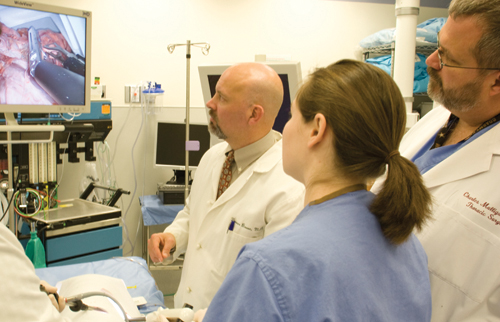Simulating video-assisted lung surgery mirrors the real thing


Clinical reviews of cases at Christiana Care demonstrate that minimally invasive thoracic surgery often results in shortened length of stay, improved postoperative pain and decreased use of postoperative narcotics. Yet, fewer than 30 percent of all lobectomies in the U.S. are performed using a minimally invasive technique, according to the Society of Thoracic Surgeons.
A lobectomy is the removal of a part of a patient’s lung to cure lung cancer.
“A great majority of my lobectomies are performed with this approach,” said Thomas Bauer, M.D., chief of thoracic surgery in the Department of Surgery at Christiana Care. “The primary reason too few minimally invasive techniques are performed around the country is the lack of training. Training sites such as ours will hopefully impact this statistic.”
In February, Dr. Bauer and fellow thoracic Surgeon Charles Mulligan, M.D., completed the first training session for Christiana Care residents to perfect their video-assisted thoracic surgery (VATS) techniques at the John H. Ammon Medical Education Center.
As vice president of the Philadelphia Academy of Surgery, Dr. Bauer is addressing the training issue at the regional level, offering surgeons, residents and fellows around the Mid-Atlantic region opportunities to learn at the world’s first accredited Level II Institute Virtual Education Simulation Training Center at the John H. Ammon Medical Education Center.
“Since most other hospitals do not have this ability, we will open the center and our expertise to other training programs in our area,” Dr. Bauer said. “It is our expectation from the initial review that we will become a thoracoscopic training site for regional thoracic surgeons in the near future.”